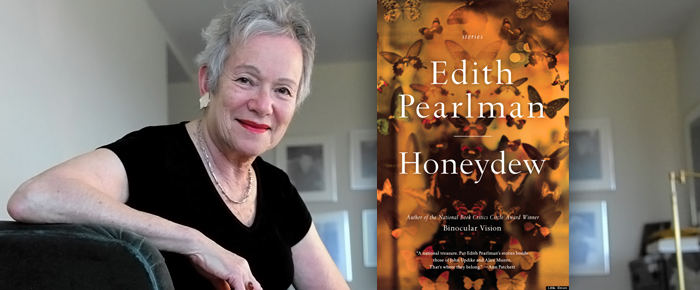
By Heidi Simmons
—–
Honeydew
By Edith Pearlman
Fiction
—–
There are endless tales of how we humans toil with life. In Edith Pearlman’s Honeydew (Little, Brown and Company, 279 pages) we get a taste of the eccentric in 20 short stories.
In “Castle 4,” Zeph Finn is a socially awkward anesthesiologist who finds love with a dying patient. The hospital is a Victorian Gothic building constructed after the Civil War. It is nicknamed the Castle for its balustrades and turrets. Although it is old, it has been kept up and modernized.
Yet there is something creepy about the place and the role it plays in the lives of those who live in the community. Finn carries a walking stick and prides himself on his organized surgical cart. “He always wore a jacket and tie to work. You would expect these garments to smarten him up. In fact they made him seem more shambling and unaware: a tall loose-limbed guy carrying a stick for no purpose.”
Finn shows compassion for his patients and takes his job seriously. He’s a good listener and provides the right amount of drugs and pain relief. When he meets Catherine, he knows she will not live and that eventually the drugs will have little effect. His solution to the undeniable outcome is to provide love. So he marries her.
“Blessed Harry” is the story of Mr. Flaxbaum, a husband and father of three boys, who is invited to speak about “The Mystery of Life and Death” at King’s College. Feeling honored and proud, his family shares his delight and congratulates him. He is a teacher at a private girls school and wonders what brought him to their attention.
By the end of the week Mr. Flaxbaum discovers the invitation was a hoax. But the love and respect of his family sooths the hurt. “At some point he’d probably caught the aroma of scam that the rest of the family had sniffed — erroneously, they’d hoped — from the start. She saw him standing next to the computer, his head lowered, his glasses at the end of his nose, one stubbly finger on DELETE.”
In the story “Conveniences,” Amanda and Ben are living together in a sublet near campus, where she is a student and he is a professor. Amada is writing a paper on ‘Connubis’ a coined word for being as if married. Her thesis is that conventional marriage is out-of-date. People no longer marry for security and there is no advantage to being married.
Pearlman writes: ”He particularly respected Amanda, whose upright Maine family he also respected. Once, years ago, he loved her older sister, presently married. Now he loved Amanda, but in a casual way.”
Ben goes along with her ideas. But when the sublet is nearly up, Amanda decides to move out and move in with another man. Suddenly Ben is confronted with his real feelings for Amanda but is unable to do anything but embrace it.
The books title story “Honeydew” is about Emily, an anorexic girl whose only interest is insects. Her mother and father are perplexed as to why she won’t eat and she is often hospitalized and force-fed.
Emily gives a fascinating lecture to her classmates on ant anatomy, how they eat, share food and build their society. Through Emily we learn that manna, found in the desert and eaten by the Israelites, was a type of sweet insect dung from beetles. It was not a miracle of god but Coccidae excrement. “Ah, Coccidae. She could draw them — she loved to draw her relatives — but unfortunately the mature insect is basically a scaly ball: a gut in a shell.”
For Emily, she discovers there are moments of sweetness, but sometimes they are hard to swallow.
Author Pearlman sets many of her stories in a town call Godolphin, Massachusetts. Several characters and places reappear crossing over into other stories. This continuity gives the stories gravity and creates an intimacy that engages the reader as we become familiar with the places and the people, as in a novel.
What Pearlman does really well is include a B and sometimes a C story that weaves in and out of the main character’s narrative. For being short stories, these minor characters have an equally interesting role in the bigger world of the main character.
A mostly female centric collection, Pearlman stories are about young, old, single, married and widowed women. She does not shy away from sexism or sexuality.
Her story, “What the Ax Forgets the Tree Remembers;” is about Female Mutilation and the differing views of two women who have suffered the terrible ritual. Pearlman shows the reader there are things which we think we understand but will never understand.
There are times reading Honeydew that I required a dictionary. And some of the stories I had to mull and reread. But it’s worth the effort.
Pearlman is 80 years old. Her wisdom and observations about women and men are honest, brave and insightful. Honeydew looks into a world of people who must work at life. Sometimes the fruit of our labor is sweet and sometimes it’s bitter.









































